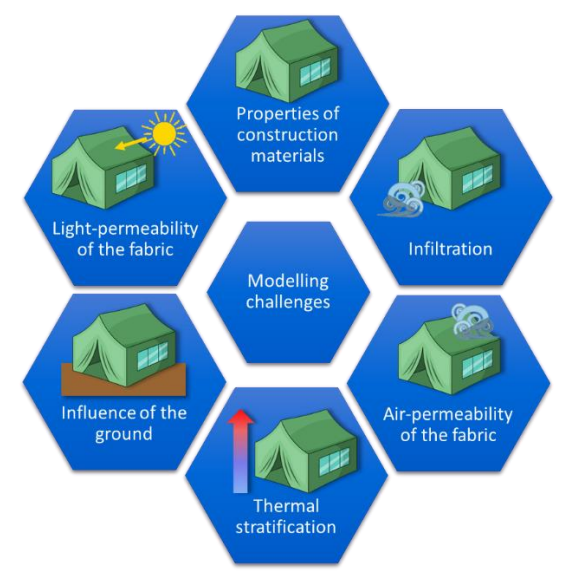Information
| EngD trainee | Agata Rijs |
| University supervisor | dr. ir. R.C.G.M. (Roel) Loonen |
| Company supervisor | Klaas Hilverda |
| Name of company | Ministerie van Defence |
| Period of project | Sep 2018 – Aug 2020 |

Summary
This PDEng project was initiated by The Dutch Ministry of Defense. The aim of this project was to design and develop a software tool supporting the decision-making on HVAC systems’ capacity for military tents.
Military missions and training take place all over the world, very often in countries where the weather conditions are extreme. During missions, soldiers live and work in temporary infrastructure, especially in military tents. The tents act as sleeping quarters, relaxation rooms, dining halls, offices, storages, field hospitals, or even hangars. To ensure an acceptable indoor environment, the tents are equipped with heating, ventilation, and air-conditioning systems (HVAC). While preparing a military mission or training, it must be decided what capacities of the HVAC systems must be provided. The decision is difficult because of the large variety of factors influencing the choice, such as characteristics and intended function of a determined tent, and local weather conditions. Moreover, the decision is usually made by experienced and technically-skilled people, whose core activities are not necessarily related with HVAC systems.
To support these decision-makers with their task, this project delivers a decision-support tool (DST) that provides information about the required capacity of the HVAC system, the consequences of the application of a lower-capacity system, cooling and heating energy demand, thermal comfort and safety. This tool meets requirements that were identified in the requirements specification process.
The requirements specification process was an important part of this project. This specification was realized with the use of some techniques that helped to organize information that was collected during interviews with the advisor from The Defense Organization responsible for this project. These requirements established that the DST to be delivered at the end of this project would be userfriendly, flexible, and reliable. User-friendly means that it should be fast and intuitive for the user. Moreover, the DST inputs must be limited to the information that the user can collect and the outputs should provide the necessary information but not be confusing. Flexible means that it must cover a wide range of possible cases. Reliable means that it must provide correct results. These three requirements are conflicting with each other. Therefore, the main challenge of the project was to find the right balance between them.
The developed DST has the following advantages:
- The DST input form was developed in MS Excel, which is a software that the client is familiar with. The input form contains short instructions explaining how to fill in each input cell. It also includes default settings to make it easier to fill it in. However, if the user wants to go beyond the default settings, it is also possible to fill in additional, more detailed input cells, that make the DST very flexible.
- The DST has been built on top of a well-known and reliable building performance simulation program. The model considers the dynamic interactions between the tent, occupants, equipment, weather conditions, and the HVAC system. The user can run the simulation directly from the Excel input form by one click. The fact that the user can run the simulation by himself provides large flexibility and enables the calculation of an unlimited number of possible cases.
- The DST provides results in a PDF report format. The report containing information that is crucial for HVAC systems sizing is automatically displayed to the user. The information allows the user to 3 make a risk-aware decision instead of deciding for the user. If the user wants to get information about energy demand, thermal comfort, or heat stress risk, he can open an additional output report by one click in the input form.
- The DST can be used for the sizing of HVAC systems but also for demonstrating the effects of weather conditions, tents’ properties, and shading application on the thermal comfort and heat stress risk in military tents.
- The DST provides extensive user support.
- The DST is also future-proof, it can be used for tents currently owned by the Dutch army as well as tents that will be purchased in the future.
As shown above, the mandate of this project to develop a user-friendly, flexible, and reliable software tool for decision-making on HVAC systems’ capacity for military tents was achieved.